
Opuntiella californica
Red Opuntia, Prickly Pear Seaweed
Gonzales Bay, Juan de Fuca Strait, Victoria, British Columbia, Canada
December 1 – 3, 2020
Observations started at 2:45pm PST, December 1, 2020, and intentional interactions and observations commenced at 9:30am PST, December 3, 2020.
Tide: (time of specimen discovery) 9.2 feet (measured at Oak Bay Tidal Station)
Weather: Mostly cloudy, no precipitation, wind calm, smooth sea with very light southerly swell, temperature 9˚C, relative humidity 88%.
Phase of Moon: Waning Gibbous (approx. 85 hours past the New Moon); (Previous Phase, Full Moon, 30 November 2020 at 1:29am PST: Next Phase, Third Quarter, 7 December 2020 at 4:36pm PST.)

Figure 1: Opuntiella californica, Prickly Pear Seaweed/Red Opuntia – displayed on a beach log after being torn from its holdfast and washed ashore by a severe winter storm. Gonzales Bay, Juan de Fuca Strait, B.C., Canada. December 1, 2020. Photo ID 27429 ©Seaweedwhisperings.com
Pre-Intentional Observation & Interaction Events & Insights:
Person 2:
I went to explore the sea coast in the morning following a severe winter storm. I was curious about what might have been tossed ashore after having witnessed the power of the crashing surf here yesterday. The storm of November 30th (a full moon and lunar eclipse date) was intense and lasted for many hours (through all the day’s tide cycles). Southwesterly winds of 50 to 70 km per hour prevailed and gusts were recorded at the nearby weather station of 92 km per hour (the latter ranking in the category of hurricane force winds). At the beach I noted many species of familiar seaweeds in the high tide duff – mixed among the eel grass and small driftwood pieces were pieces of Sugar Kelp, Sea Cabbage, Bull Kelp, Red Sea Fan, Turkish Towel, Sea Sacs, Bladder Wrack, Split Kelp, Wiry Acid Weed, Succulent Seaweed, and even one tattered piece of our current and ongoing Whispering ‘subject’, Giant Perennial Kelp. The representative array of algae was impressive, yet the biggest surprise of the day was to encounter a beautiful example of Prickly Pear Seaweed! There it was, Opuntiella californica, tossed up on the beach and standing out in color and form from the rest of the masses of seaweed.
I had only discovered this seaweed one time before in all my forays to multiple intertidal regions – and this individual was a prime example of the species! I knew my Whispering partner had never yet seen this seaweed, and I had little time before I was due at another appointment...., so, since the Opuntiella had already been torn from its home, I chose to bring it home. Person 1 and I were just currently wrapping up the Macrocystis pyrifera Whispering and were therefore not free to consider immediately immersing ourselves in the energy of this one. It felt like a true example of the expression “an embarrassment of riches”, as this day on this one local beach revealed at least four more species of algae that we would be honored to interact with and ‘listen’ to. Alas, one at a time is the way we best know to proceed! But…, I could at least “show and tell” and also keep the seaweed safely stored in seawater for the next day’s light so I could document it with photographs.
Person 1:
As Person 2 returned home from exploring the seashore (soon I learned that she had collected the Opuntiella) she summoned me, waving from down the road. I sensed her excitement, and I became excited also in anticipation of the unknown.
Most of my pre-intentional-Whispering insights occurred to me while I was acquiring sea water to refresh the Opuntiella specimen.
Radiating sexuality – natural sexuality, not forced or exaggerated.
Highly seductive – the shapes and form of the specimen – rounded, it was round and smooth, like the curves of a woman’s body. Curvaceous, attractive, certainly so from my perspective, male heterosexual, at least. I don’t know enough about female-to-female attraction but maybe there is a bisexual tendency in this seaweed as well. I was thinking, I’m attracted to this, I wonder if a woman would be, too? Perhaps...?
Reflecting on the excitement, there was excitement felt but there wasn’t urgency for action – there was pleasure in the anticipation.
When originally discovered, Person 2 had thought to keep this seaweed only until the next day’s good light to do some photography. We were currently in the midst of another interaction so were clear about wanting to complete that first. Quickly a second possibly arose – what if we care for this seaweed until we are free to focus our efforts with it? Person 2 had put this possibility to me, and the answer to go ahead with this plan came later in the day after I had interacted with the seaweed while refreshing the seawater we were keeping it in; I declared to Person 2: “This interaction has already started; Opuntiella has seduced me.”
Night of December 2nd:
I had several dreams about Opuntiella. However, when I got up in the morning I could not remember anything of the dreams. There’s something already clear about this whole Whispering and it is about putting aside pieces not relevant to the current focus. I wondered if it is an Opuntiella characteristic to not dwell on things that are deemed unimportant?
In situ observations (December 3, 2020):
We brought the seaweed back to the same area where it was discovered and interacted with / observed it on a section of sandy beach there, in a relatively sheltered area of Gonzales Bay. In the bay there are bed rock islets and this is where we suspect the Opuntiella californica had been growing before it was dislodged by the recent violent storm.
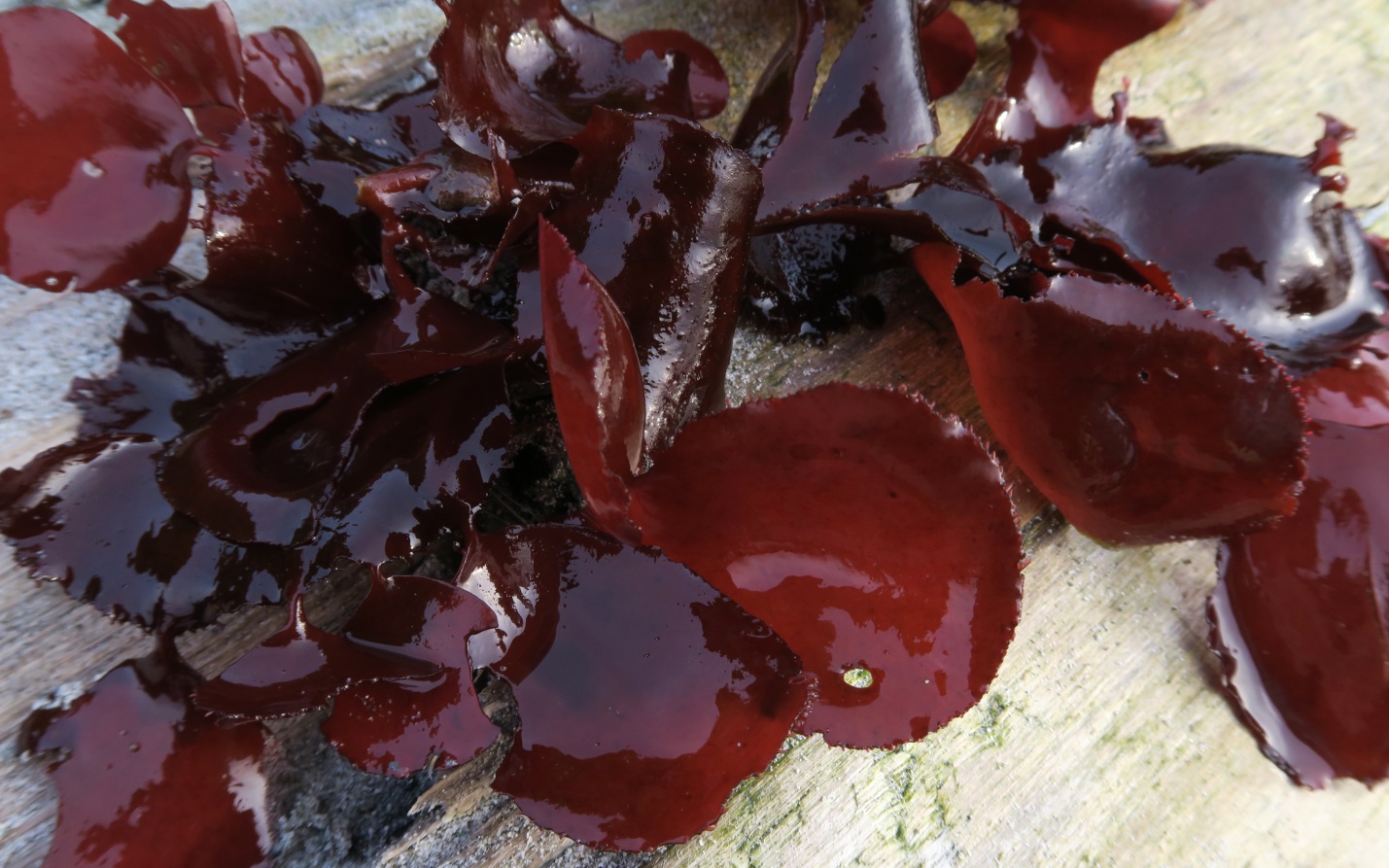
Figure 2: The rounded slightly cupped blades are prominent in this view; rich red coloring and the shiny reflective surface all combine to lend a ‘seductive’ or ‘alluring’ quality to the energy of this seaweed. Gonzales Bay, Juan de Fuca Strait, B.C., Canada. December 1, 2020. Photo ID 27430 ©Seaweedwhisperings.com
Person 1:
Opuntiella has smooth rounded cups, like bra cups hiding breasts beneath.
Multi-dimensioned but mainly in two planes.
Looks soft, but in my hands out of water it is tough to the feel and abrasive at edges.
Some cups have fine serrations or frills at their edges; with magnification I can see that the frills are “baby” opuntias.
Cups, arising out of cups, arising out of cups.
Symmetrical kaleidoscope form near the base, but loses symmetry as the seaweed grows outward.
Strong, not easily hurt.
Not fancily dressed, but nevertheless distinctive.
Can brush aside annoyance just as it can let the ocean movement glide on by.
Likes to be admired, but doesn’t let compliments go to its head.
Not susceptible to flattery but appreciates genuine acknowledgment.
Doesn’t suffer fools gladly.
Very difficult to chew.
Slightly sweet taste.
Sweet iodine smell.
Perhaps tries to mask its sexiness (unsuccessfully) to present publicly a more ‘proper’ face.
Could be lonely and have difficulty finding or maintaining solid personal relationships.
Spends more time in the mind than in the body. Thinking about the ‘opuntia’ shape – it has mostly heads, and not much else. Almost everything is “in the head”.
Vision of a queen with many lovers or suitors.
“Opuntiella” – lovely sweet lilting sound to it.
“Californica” – location description.
Prickly Pear Seaweed and Red Opuntia – good names describing appearance.
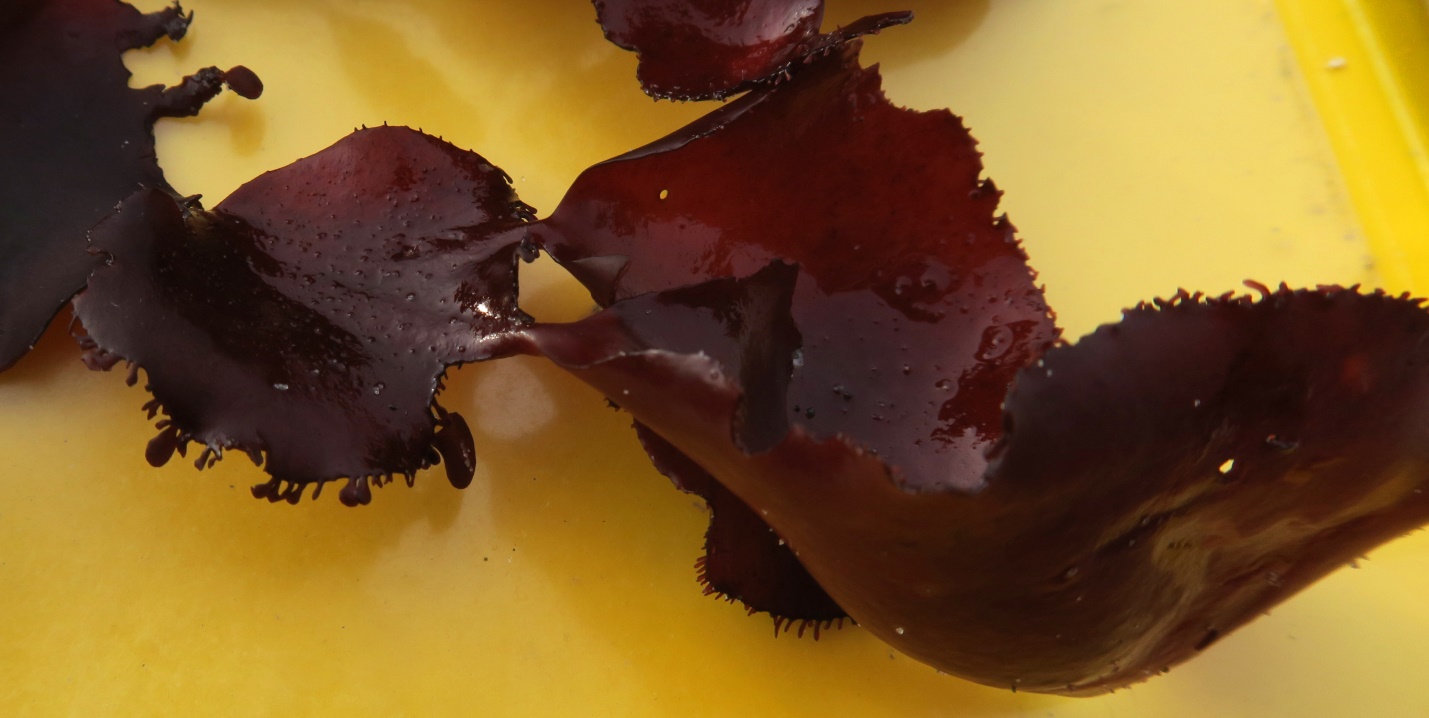
Figure 3: Opuntia californica, Prickly Pear Seaweed – close view shows the new growth at the blade margins and the strong connecting stems between blades; Gonzales Bay, Juan de Fuca Strait, B.C., Canada. December 3, 2020. Photo ID 27431 ©Seaweedwhisperings.com
Person 2:
Stunning Red Opuntia seaweed – I found you here in the high tide duff two days ago. You beckoned me with your rich red color and clean rounded form. I know, from a past discovery elsewhere, that you are a species of mainly subtidal regions. So, while your detachment from your home is indeed a loss, to find you here is a rare and special treat.
We have kept you as safe as we could, fresh seawater kept at cool at near to ocean temperatures – and returned here today to the seashore to interact with you.
Glowing, rich ruby red – what a splendid color you are. It makes me think of royalty, jewel tones, riches and depths of plenty.
Your first stipe, arising from your holdfast, is a short, somewhat flattened cylinder that leads to a wedged shaped formation. There are then another few wedge formations and then very soon after you grow in your favorite form – at the margin of an existing flat blade you grow in a generous broadly formed and gently cupped circle.
The edges of these blades are trimmed with tiny projections, like a delicate lace trim. The younger blades are literally rimmed with this “trim”, and the most mature blades have far less of it. Did the projections break off, or if they weren’t positioned well, did the plant stop serving them with nourishment so as to reserve and dedicate energy into the dominant young blades?
Some of these tiny “trim/lace” pieces are forming small new blades. Starting like a teardrop shape, then widening into a rounded fan, and finally expanding into a broad and generous cupped circle as the overall size increases.
This soon means the overall plant is a “collection” of red circular shallow cups – the circular cups grow only from earlier ones and so the effect is that of tiers. It is a multi-tiered growth pattern, with each tier having a strong horizontal presence. Vertical rise is not sought by this seaweed, at least not with any great strides such as with the kelps.
Taking the overview of a mature plant I see it looking rather like some movie models of some space ships or space stations with circular pods that inter-connect via narrow airlocks, or like some type of fungi (reminiscent of the oyster mushroom, Pleurotus ostreatus) that features circular domes, or rounded fan shapes, each connected to the next.
This seaweed as a whole has a rather pleasing look; it is not crowded and messy. It is rather a lovely expression of circles nesting in proximity to each other yet with sufficient space for each to broadly fill out.
Distinctive – this growth pattern is distinctive compared to any other red alga I know. And while I could argue that each of the algae have remarkably different morphologies, the way that Opuntiella californica chooses to grow has a quality that sets it apart.
And yes, the growth of these ocean-dwelling algae is very reminiscent of the growth habit of the land dwelling prickly pear cactus (Opuntia sp.). One could even imagine that the irregular trim at the leaf margins are tiny red spines – just like the cactus.
Your blades, even though somewhat translucent, are really remarkably tough – almost like a thin piece of leather. The texture might be considered rubbery, but there is no stretch to it at all.
The blades are smooth to touch, cool, and slippery to glide my fingers over.
It’s pleasingly sensual to do this – there’s no resistance to my touch, and also no clinging grip – only smoothness that pairs with an underlying resilience and strength.
Yes, resilient – if I tug on one blade, even though it is connected to the previous by a narrow and very short stem, you are not weak, not even at the joints. You hold together – strongly, Opuntiella.
Studded – each blade is studded with the possibility of many more. Studded, diamond studded, ruby studded, like a crown resplendent with jewels.
And you are not just the crown; you are the rightful wearer of that crown, Opuntiella.
You are the queen, the empress, the tsarina, the peak of the red seaweeds in your expression and form.
You enjoy the “peak”, it suits you, looks grand on you, and you naturally and comfortably belong there.
I think this is why I felt finding you was SUCH a rare thing – because you don’t willingly leave your “throne” and who, indeed, is granted an audience with the queen very often?
We rearranged our week so we could accommodate this “special appearance”.
We recognized the invitation as special and not to be passed up.
I bite you – a few chews and I spit you out.
Strong iodine taste and unpleasant texture.
Where I bit the blade, it broke away in rather clean lines (not simply as an outline of my teeth like a more tender substance would do) – thus revealing that your blades are uniformly thick – about 0.8 mm thick.
No structure is visible in that thickness – it is all uniform alga tissue.
This seaweed smells of iodine, too, quite distinctly.
I want to hold you up to the sky, to see you back-lit. Your red color is uniform, too, and it is the rich red of beautiful stained glass.
While you suffered some breakage from being washed ashore, I doubt you are troubled by hungry herbivores – maybe they don’t like the taste of iodine either!
With all the potential new “opuntias” at your margins, I wonder what makes the difference – what sets apart one of these protrusions so that it is “the one” that grows into a new generation of royalty, the next tier, the heir apparent?
Ah…, yes, the “position” matters! The tiny teardrops that will ultimately grow into the few round and full blades of the next tier, they are not crowded together like birds huddled on a wire, but they are spaced such that they will grow to prominence. You are not one of many in a crowd, Opuntiella californica, you are much more special than that.
Set apart.
Special.
Prominent.
You have eminence, stature, distinction and rank.
And, you are beckoning…, even alluring.
And to whom will you respond – which lured and beckoned suitor will you choose?
You are choosy, yes, and you expect fealty. And you give selfless commitment to the duties and obligation of your position and therefore not so much to your lovers.
You are a deeper red than fresh blood, but I think “blood” matters to you, it matters very much.
Your color is like spilled blood, oxidized somewhat but not yet blackened.
And there are those who would spill their blood for you, willingly die for you – such is their dedication and commitment that you live on, thrive and flourish.
[Note: this theme, spilled blood, links to Opuntiella in its endemic distribution. See a short summary of the Battle of Attu below in the Historical, Biology & Natural History Information.]
My, oh my, royal Opuntiella, you are recognized, appreciated and revered!
The rightful queen of your kingdom.
You need to stay in your kingdom, though. This seaweed does not like to be exposed to air; it suffers quickly from desiccation and is ill prepared to be out of its element.
[Note: the concept of endemism (see Distribution notes) – having a limited range, echoes this place-specific aspect.]
So, the queen is not queen everywhere – her “position” is place-specific.
To another this could feel quite limiting – they see, Opuntiella, that you are not free to wander and explore, you cannot venture far from your “place” or you will lose your majesty – your sovereign power; you’ll most certainly fall from the “peak” and if that isn’t harsh enough penalty, you may also be vulnerable to physical harm or attack.
You graciously accept this “limitation”, though – to you it is what is right and proper.
You can do this with ease. You were born to it – “blood matters”.
It is your birth-right and your birth-duty.
Duty, yes, you shoulder your responsibilities well.
You’re firm but also fair. Your presence and influence ensures order in the kingdom.
You are a beloved monarch.
“Opuntiella” – pretty to voice aloud, a feminine sounding name. “Opun” has the feel of something spacious and grand – the “iella” is what lends the femininity to the name.
“Californica” – a rich region, a vast new “territory”.
Prickly Pear Seaweed – fitting comparison to the desert loving land plant – similar shape, growth pattern.
Red Opuntia – emphasis on RED – this is a defining red – it is true, pure, and special.
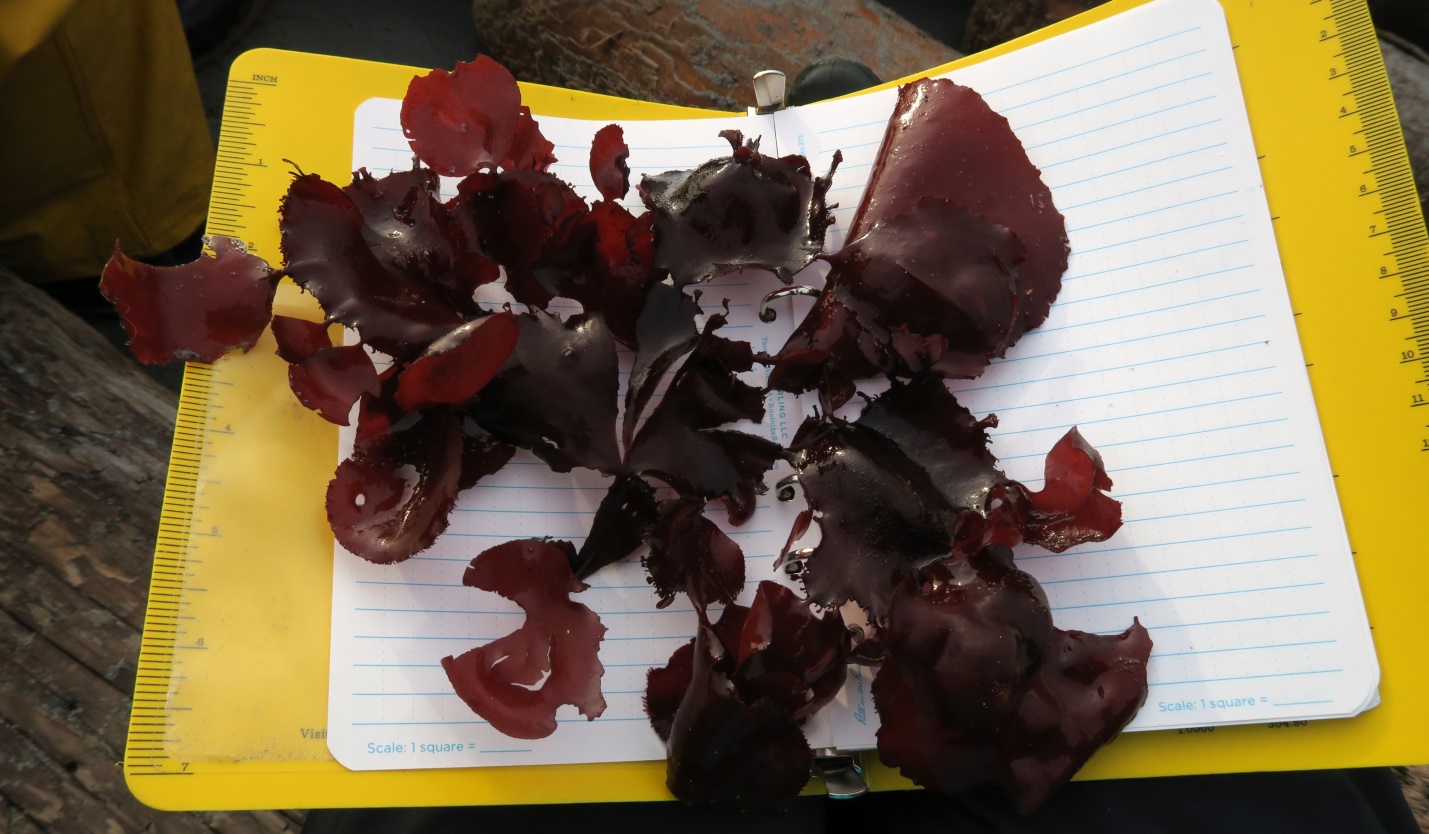
Figure 4: Opuntiella californica, Prickly Pear Seaweed – whole plant laid out on field notebook, central area reveals the wedge formations that give rise to the tiered successions of cupped circular blades. This seaweed is one that would be best photographed underwater as its form looks messy in one dimension, but is not disordered at all when immersed in the ocean waters. Gonzales Bay, Juan de Fuca Strait, B.C., Canada. December 3, 2020. Photo ID 27432 ©Seaweedwhisperings.com
Discussion:
Very early on in the seaside interactions, Person 1 felt annoyed by the ‘focus’ he saw in Person 2’s photography efforts. He noted that Person 2 was VERY focused – not even distracted by dogs, birds or roofing construction hammering. She was so focused that she seemed edgy – and she was annoyed when Person 1 wasn’t right there, ready if she needed assistance in that goal. Person 1 was mildly annoyed with this fixation. Person 2 even sharply said, “Are we birdwatching here or what!” Upon review of this Person 2 agreed that she felt unusually compelled to create the best images she could of this seaweed – to make an “official portrait”, perhaps? She experienced it almost as a ‘duty’ that she mustn’t neglect or fail in. She also felt influenced by a second factor which was about the ‘rarity’ of finding this seaweed. It is NOT common. She was conscious that if she didn’t capture good images now, who knows when, or even IF, there’d be another opportunity.
Two words stood out as ‘must be’ used in our observations that felt somewhat odd if simply considered literally. One of these words was “tiered”. This does describe the layered growth habit of Opuntiella, and tiered is descriptive of the grades or levels within a hierarchy such as a monarchy. “Tiered” also linked, in the contortions of Person 2’s mind, with the word “tiara”. Tiaras are worn by women, crowns are worn by both men and women, and this is an example of one of the numerous ways we came to refer to this seaweed as female. The other word ‘must be’ used word was “studded”. This word appeared as a verb, describing how the tiny opuntias “mark or decorate conspicuously at intervals” the margins of the seaweed’s blades. It wasn’t quite a perfect word fit and felt like an odd choice initially, and then the second meaning was realized and seeing why it must be used was clear. A “stud” is “an animal, especially a horse, kept primarily for breeding”. This parallels with the theme of rarity and also the maintenance of royal blood lines.
During the Whispering Person 2 had the strong desire to bring out and display her red and turquoise and golden colored seasonal ornaments. She has owned these colorful baubles for years, but today having the gleaming colors on display gave particular pleasure. Remembering Person 1’s notion of “unrequited love” we pondered if jewels are a monarch’s “consolation prize”. You may not be able to marry the object of your heart’s desire as you have a greater duty to enrich and strengthen your kingdom through marital union. Possibly jewels ornament the ‘noble person’ who on their own is not so physically beautiful – jewels can make the person more attractive decoratively and momentarily, as they often have great value. Perhaps the jewels give a chance to fantasize..., in their rich tones and with their many facets, possibly this gives a freedom of sorts and that could impart great pleasure.
Whatever the reason, the shining red color of this seaweed IS special, regal, and as in the case of red stained glass – expensive. The tint is derived from gold, not other less precious substances. Richness is expressed inherently in this seaweed’s energy – it is obvious in a deeply sourced and forthright manner.
In this Whispering it was notable that new impressions kept occurring to us, and so we kept the interaction “open” for some time longer than had been our usual. The idea occurred that maybe each impression was a like an aspect or a “world complete unto itself” – like the morphology of the alga itself, and that we could only examine one facet, only one round opuntia circle at a time. To continue on to another requires exiting out the single stem and then finding a new facet, or rounded blade, another “world” unto itself. Things are not linked up like a chain in this design.
Compartmentalization is a key tool for operating in a position of much responsibility where official duties vary in importance and urgency.
As an individual you also compartmentalize your thoughts, actions and most often your feelings if you are to be a steady guiding influence. As a natural consequence of the position, personal feelings are relegated to low priority.
Compartmentalization is another type of “focusing” which was a trait expressed at the very beginning of this Whispering. The focus is firm and certain, nothing will break it.
From the beginning we acknowledged that what would attract one person to this seaweed’s energy might be quite different from what would attract another. Opuntiella is broadly experienced and knowledgeable, her upbringing and training has breadth and depth. She has mastery in many areas, and this makes her attractive to a wide range of individuals. Few others, though, can match her worldliness and meet her in each facet of her being.
She also doesn’t suffer fools gladly – offer me something of value or interest, or don’t waste my time. Opuntiella feels impatience and annoyance with things that are not useful, that might be inconsequential or trite. She recognizes value and appreciates it, demands it. So freshness and creativity and quality, these are things she seeks.
And she does encounter a fair number of “fools”; her innate majesty attracts all kinds. Opuntiella simply brushes aside irrelevance with her firm demeanor. She can handle most of this graciously but doesn’t tolerate insincere or manipulative approaches. She doesn’t have to voice her displeasure or impatience; it is easily understood by those in her presence.
Committed to responsibility. This occupies much of her time, leaving little opportunity for exploration beyond duty. We did not feel that Opuntiella feels any self-pity about this lack of freedom, not at all! She is committed to the well-being of her kingdom.
She is at the top through lineage and tradition. She maintains this by being responsible with her breeding – she has her heirs in waiting. However, her inherent sexuality may also result in illegitimate offspring. Only her formal heirs, though, receive the wealth, the best of the kingdom’s riches. The others are cast aside – for them she has no favor.
Opuntiella has a rich life, indeed, but rewards in some areas are not possible – mainly in personal pleasures and freedom of choice in close personal relationships. So she puts on her crown, chooses ‘head’ over ‘heart’ and is a noble example of regal magnificence.
Leaving the seashore/returning specimen to the sea:
When we completed our observations and interaction we took the seaweed out into the shallows of Gonzales Bay and released it.
Person 1:
Opuntiella didn’t leave us when returned to the sea, maybe she wants to impart some more? Or, pondering further on this “parting” I had the impression of the seaweed slipping away, maybe associated with feelings of unrequited love, as if it had missed something. That there had been a possibility but it just was not to be.
Person 2:
Released into the bay, the seaweed remained floating in the shallows, adrift, pulled in and out with the ceaseless waves of the ocean swell – this is NOT its proper state. I could feel the seaweed’s discomfort and distress – it knew it had been permanently dethroned.
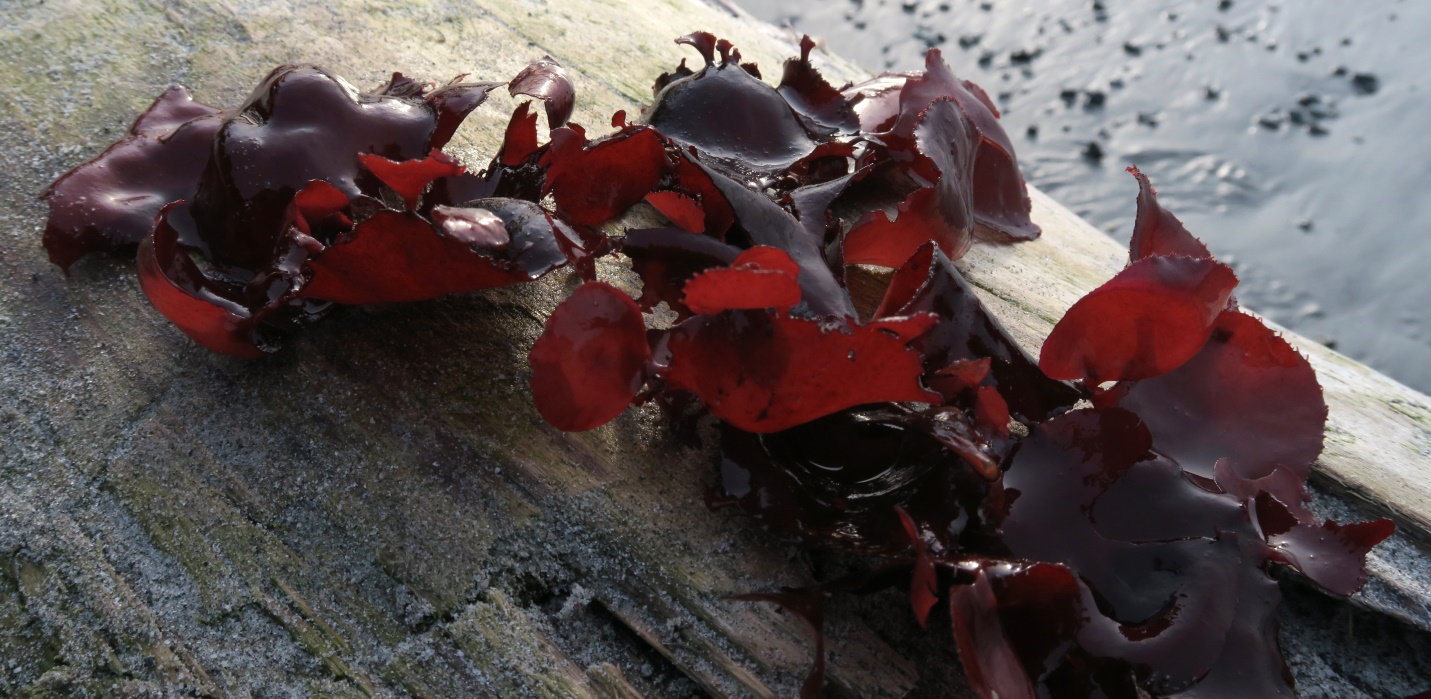
Figure 5: Opuntiella californica, Prickly Pear Seaweed – back-lit perspective highlights the red coloration, the full curvaceous mature blades as well as the younger blades newly growing at blade margins; Gonzales Bay, Juan de Fuca Strait, B.C., Canada. December 3, 2020. Photo ID 27433 ©Seaweedwhisperings.com
Biology & Natural History Information:
Description:
Plants, reaching up to 20 cm tall and 30 cm wide, grow in an easily identified circular branching pattern. A single primary blade arises on a short stipe (up to 8 mm long) from a fleshy discoidal holdfast. The blade reaches average sizes of 15 cm in diameter and is dark red, thick, and rather tough or cartilaginous in texture. From the primary blade varying numbers of secondary blades arise from the margins; and this pattern is capable of being repeated to several orders.
Red Opuntia has a heteromorphic alternation of generations. The large upright gametophyte phase that we recognized and worked with in this Whispering and the microscopic tetrasporophyte which is crustose. So different was this minute spore-bearer phase that it was originally described as another species, known as Cruoria profunda.
Habitat:
Opuntiella californica grows in rocky semi protected to exposed habitats in the extreme low intertidal and subtidal regions (to 20 meters). South of Washington state, it is found sub-tidally only.
Pacific Coast (and World) Distribution:
Endemic to western North America from the Attu Island, Aleutian Islands, Alaska to Baja California, Mexico.
Remarks:
This is the type species of the genus Opuntiella.
This species superficial resemblance to the prickly pear cactus, genus Opuntia, results in both its scientific and common names.
During World War II Attu Island, and the Aleutian Islands as a whole, were held by US generals as being “the most important strategic place in the world”. On June 7th 1942, the Japanese Imperial Army, landed unopposed on Attu. The recapture of Attu by American forces is chronicled in WW II history books, a 19 day conflict that climaxed in a brutal hand to hand combat Banzai charge led by Colonel Yamasaki. The Japanese Colonel and over 2,351 Japanese perished over the course of this battle, as well as 549 American soldiers.
Classification:
Phylum: Rhodophyta
Class: Florideophyceae
Order: Gigartinales
Family: Furcellariaceae
Genus: Opuntiella
Species: Opuntiella californica (Farlow) Kylin 1925
Former name(s): Kallymenia californica Farlow 1877, Cruoria profunda E.Y.Dawson 1961.
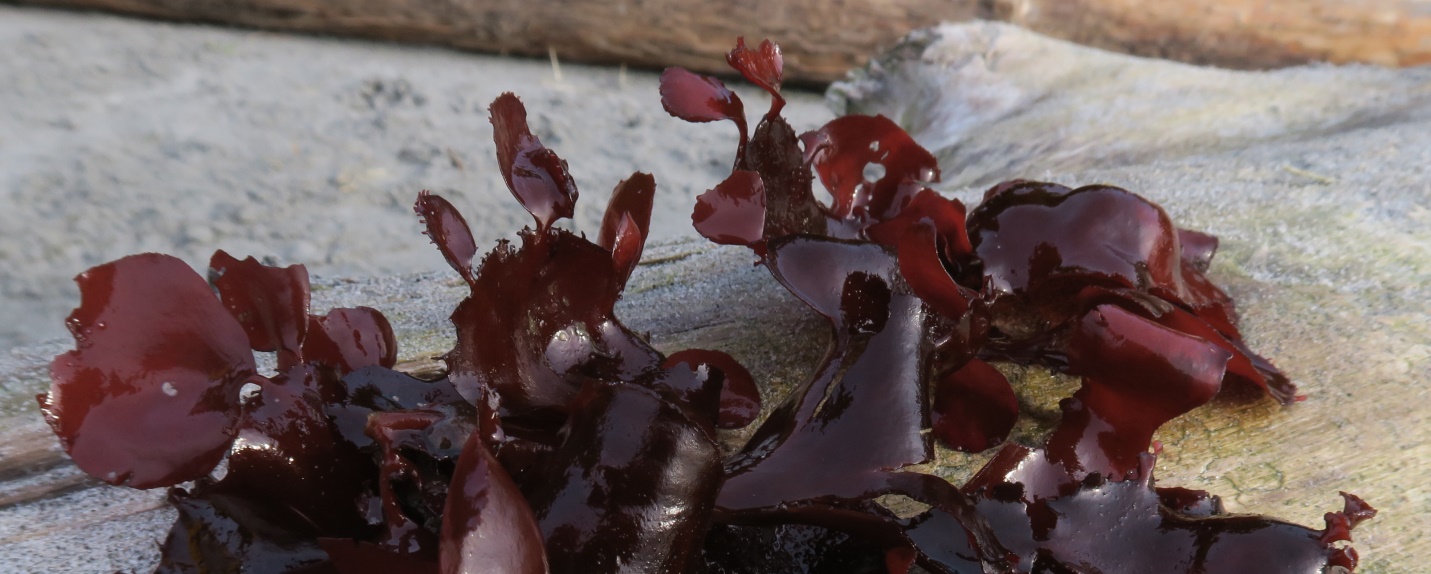
Figure 6: This view is angled to show the crop of new ‘opuntias’ that are growing from the margins of several older blades. Gonzales Bay, Juan de Fuca Strait, B.C., Canada. December 3, 2020. Photo ID 27434 ©Seaweedwhisperings.com
![]()